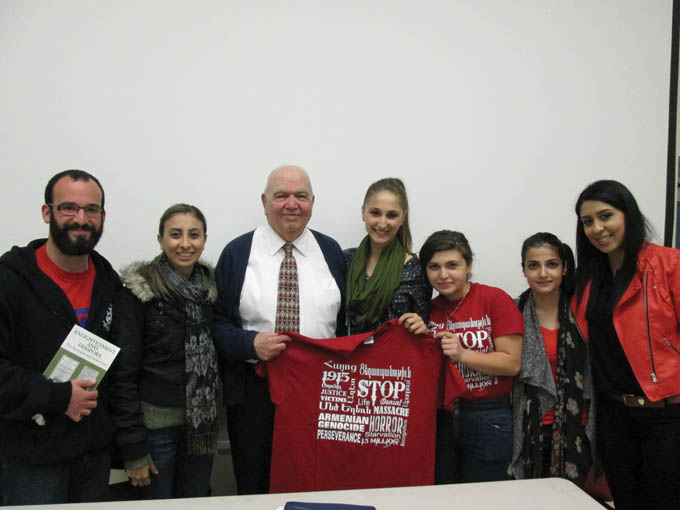
and Ovsanna Simonyan. Photo: Barlow Der Mugrdechian
SUREN OGANESSIAN – Staff Writer
Cappadocia, a region in central Anatolia just west of the Anti-Taurus mountains, has a marvelous, mountainous landscape, dominated by tall rock formations called “fairy chimneys,” and featuring ancient churches built into solid rock and in secret caves, from a time when Christianity was frowned upon by Islamic Arab rulers. Unsurprisingly given its proximity to historic Armenia just to the east, Cappadocia has played a key role in Armenia’s history from ancient to modern times.
The latest in Professor Richard G. Hovannisian’s ongoing series of books detailing regions of historic Armenia, Armenian Kesaria/Kayseri and Cappadocia, charts the history of the region as it relates to its once-thriving Armenian population. A frequent visitor to Fresno State, Dr. Hovannisian returned on Friday, April 25, to present a talk “Armenian Kayseri,” as part of the Armenian Studies Program Spring Lecture Series, with is supported by the Leon S. Peters Foundation.
In a broad ranging presentation Dr. Hovannisian discussed the history of the Armenians in the region, and also brought the lecture to life with video clips. In Diyarbakir, one of the last Armenians in the city, Digin (Mrs.) Baydzar was interviewed by Dr. Hovannisian’s daughter Ani. Baydzar instantly became an audience favorite with her warm personality and modest smile. An interesting clip on the Hamshen, an Armenian speaking ethnic group, who live in the region of Northwestern Turkey, was also shown.
Dr. Hovannisian presented historic photos from the many Armenian inhabited villages that were in the region of Kayseri: Evkere, Talas, Tomarza, Chomakhlou, and Evereg among others. Through the photos the audience learned of Armenian customs, of the beautiful Armenian churches, and of the many educational institutions that once existed.
Cappadocia was a longtime cultural and political contact zone between East and West, and like the Armenian Highland region to the east, passed hands between empires several times in its history, with fleeting moments of independence in between. It was briefly a vassal state of Tigran the Great’s empire, making it a buffer state between Armenia and Rome. But for much of its history it served as one of the eastern-most provinces of Rome and later the Byzantine empire, depending on how much of Armenia the Byzantines dominated at any given time.
Armenians began moving into Cappadocia in large numbers when Greater Armenia was partitioned between the Sassanid Persians and the Byzantines in the fourth century. At different points in its history the Byzantine government, looking to weaken the powerful social structure of Armenia, either enticed or forced entire Armenian communities to move west. They would do this again after annexing the independent Bagratuni and Artsruni kingdoms between the 9th-11th centuries AD. And although the Armenians were Christian, the Byzantine Empire preferred that their subjects adhere to the Greek Orthodox Church, creating a challenge for Armenians in the area to retain their identity as a people.
By the time the Ottoman Turks took over the area in the 14th century, the challenges for Cappadocian Armenians were about the same as Armenians living anywhere else, being Christians in a Muslim-dominated empire. Armenians would maintain a presence in the region up until 1915, when the Armenians of this region were either deported or massacred in the Armenian Genocide.
Professor Hovannisian, Professor Emeritus of Modern Armenian History at UCLA, first began researching the Cappadocia region in 1997, when initiating a series of eighteen conferences on “Historic Armenian Cities and Provinces,” areas from which the Armenians were eliminated during the 1915 Genocide.
Armenian Kayseri is the twelfth volume published in the series. After three years of gathering information, editing and indexing, the newest volume on Cappadocia has now been published, and this interesting and often overlooked chapter in Armenian history is finally being given some much overdue attention.
 Hye Sharzhoom Armenian Action
Hye Sharzhoom Armenian Action